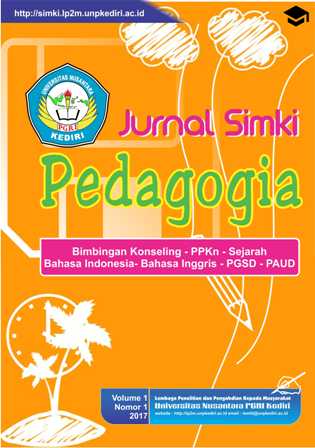CORRECTIVE FEEDBACK STRATEGY IMPLEMENTED IN TEACHING SPEAKING AT TENTH GRADE STUDENTS OF SMA NEGERI 1 KANDAT IN THE ACADEMIC YEAR 2017/2018
Author (Penulis)
RIZKINA RAHMAWATIUniversitas Nusantara PGRI Kediri
Author Identity (NPM)
14.1.01.08.0009Abstract
Abstract
Oral corrective feedback is one of strategies in helping students to improve their ability in learning English. In here, the implementation of oral corrective feedback can not be separated in teaching learning process especially in English speaking skill. Therefore, the researcher focused on what kinds of oral corrective feedbacks the teacher used in teaching English especially in speaking class. This research aims to answer the research problem about: what kinds of corrective feedbacks were implemented by teacher of the tenth grade at SMA Negeri 1 Kandat in the academic year 2017/2018. The method of this research is qualitative. The subject of this research was English teacher who taught speaking of tenth grade in X-A4 class at SMA Negeri 1 Kandat. The technique of collecting data were interview, documentation, and observation. Also technique of analyzing data were data collection, data reduction, and data display, conclusion drawing and verification. The study found that there were only five implemented oral corrective feedback out of six types. There were explicit correction, recast, clarification request, metalinguistic, and repetition. The most used oral corrective feedback was recast and the least used type was clarification request. The teacher did not apply elicitation. Those five tyes of oral corrective feedbacks were found in the process of teaching. Based on the findings, the researcher would recommend the teacher to use proper corrective feedback and understand the effect of each corrective feedback toward students’ speaking ability wisely.
Key Words : Teaching speaking, corrective feedback strategy
Keyword
aReference
REFERENCES
Ananda, D. R. (2017). Student’s Preferences toward Oral Corrective Feedback in Speaking Class at English Department of Lambung Mangkurat University Academic Year 2015/2016. Lambung Mangkurat University Banjarmasin.
Arikunto. 2006. Prosedur Penelitian Suatu Pendekatan Praktek. Jakarta: Rineka Cipta
Asnawi, Zulfikar T., Astila, I. 201. Students’ Perception of Oral Corrective Feedback in Speaking Class. Banda Aceh: Syiah Kuala University.
Bryman, A. 2006. Integerating quantitative and qualitative research: how is it done?. London: SAGE Publication.
Brown, D. 1987. Principle of Language Learning and Teaching. White Plains, NY: Pearson Education.
Brown, D. 2001. Teaching by Principles and Interactive Approach to language pedagogy. New York: Longman Inc.
Brown, D. 2004. Language Assessment: Principles and Classroom Practice. White Plains, NY: Pearson Education.
Brown, D. 2007. Principles of Language Learning and Teaching, Fifth Edition. White Plains, NY: Pearson Education.
Fauziati, Endang. 2008. Teaching of English as a Foreign Language. Surakarta: Muhammadiyah University Press.
Fauziati, Endang. 2010. Teaching English as a Foreign Language (TEFL). Surakarta: Era Pustaka Utama.
Florez, M. C. 1999. Improving Adult English Language Leaners’ Speaking Skills. ERIC Digest.Washington DC: National Clearing house for ESL Literacy Education.
Gibbs, G. & Simpson, C. 2004. Learning and Teaching in Higher Eduaction.
Hattie, J., Timperley, H. 2007. The Power of Feedback. American Educational Research Association.
Larsen-Freeman, Diane. 2000. Technique and Principle in Language Teaching. New York: Oxford University Press.
Miles, M. B., & Huberman, A. M. (1994). Qualitative data analysis: An expanded sourcebook (2nd ed.). Thousand Oaks, CA: Sage.
Nunan D., Guralnik. 1995. Language Teaching Methodology a Textbook for Teachers. New York: Phoenix Ltd.
Nunan, D. (2003). Practical English Language Teaching, First Edition. Singapore: McGraw-Hill.
Olmezer-ozturk, E. & Ozturk, G. 2016. Types and Timing of Oral Corrective Feedback in EFL Classrooms: Voices from Students. Novitas ROYAL (Research on Youth and Language).
Richard, J.C. & Rodgers, T.S. 1986. Aproaches and Method in Language Teaching: A Description and Analysis. Cambrige: Cambridge University Press.
Richards, J.C. 1994. New Ways in Teaching Speaking. USA: Pantagraph Printing, Bloomington, Illinois.
Rivers, W. M. & Temperley, M. 1978. A Practical Guide to the Teaching of English as a Second or Foreign Language.
Sadler, D. R. 1989. Formative Assesment and the Design of Instructional Systems. Dordrecht, NT: Kluwer Academic Publisher.
Šolcová, Bc. Petra. 2011. Teaching Speaking Skills (Master‟s Diploma Thesis). Masaryk University.
Sugiyono. 2008. Metode Penelitian Kuantitatif Kualitatif dan R&D. Bandung: Alfabeta.
Supriyanti. 2013. Teaching Using Series Picture to the Eight Grade Students of Junior High School Ngelengok Blitar Academic Year 2011/2012. Kediri.
Surakka, K. 2007. Corrective Feedback and Learner Uptake in an Efl Classroom (A Pro Gradu Thesis in English). University Of Jyväskylä.
Tatawy, Maurina El. 2002. Corrective Feedback in Second Language Acquistition. Teacher Collage Columbia University.
Tedick, Diane J., & Gortari, Barbara de. 1998. Research on Error Correction and Implications for Teaching. University of Minnesota.
Thornbury, Scott. 2001. Uncovering Grammar. Macmillan Publishers Limited.
Thornburry, Scott. 2005. How to Teach Speaking. Longman Pearson education limited.
Wallace, T., Stariba, W. E., & Walberg, H. J. 2004. Teaching Speaking, Listening and Writing. International Academy of Education
